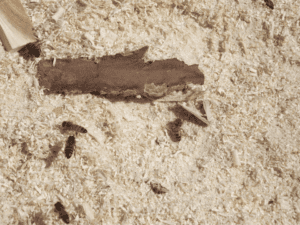
Somewhere early on in a “Beekeeping 101” class you’ll learn that honey bees forage for 4 things: nectar, pollen, propolis, and water. The nectar and pollen become honey and bee bread to provide sustenance. Propolis is used as a structural component and also contributes to colony health through immunological activity. Previous blog posts about propolis here and here provide more information. Water is necessary for a variety of purposes including preparation of brood food and evaporative cooling. So in addition to water, bees need 3 substances produced by plants. But do they collect anything else? Of course they do. If you’ve ever seen open syrup feeding, it’s apparent that the bees will forego the flower visitation part of foraging when a sweet liquid is provided. Bees will also readily gather pollen substitute when bulk fed in powder form. While these nectar and pollen surrogates may not be as attractive or nutritious as the genuine articles they are intended to replicate, they can be important in getting colonies through lean times.
Flowers and their surrogates are what the bees should be getting into, but what are they actually getting into? Some beekeepers have a perception that if bees gather it they must need it, but in my time working in and around bees I’ve seen them get into a lot of different things that probably aren’t great for them. One summer we noticed a propolis traps in a yard were yielding a dark brown, almost black propolis with sharp plastic smell instead of the typical red/orange sweet smelling propolis for the area. When we sat waiting for the construction worker with the Stop/Go sign to allow us through the roadworks where a new topcoat of asphalt was being applied, we noticed bees collecting road tar to use as propolis. This paper detected petroleum derived molecules that matched the chemistry of local asphalt in propolis from urban colonies, confirming that bees will gather sticky stuff other than plant resins. I’ve also seen bees appearing to collect silicon-based caulking product. I’ve often described the physical role of propolis in the colony as bee-glue or caulking, so seeing one bee resort to gathering our version shouldn’t come as a shock if actual resins aren’t available. Bees gather “real” propolis from a variety of botanical sources depending on geography and climate. Some of the most common propolis sources in temperate climates are members of the genus Populus which includes poplars, aspens, and cottonwoods. For more about the role of propolis in the colony and an overview of botanical sources around the world, check out this article.
It’s not just propolis collection where bees make mistakes, sometimes they get it wrong when seeking pollen too. While building woodware in the shop, I’ve seen bees take a lot of interest in the sawdust from both treated and untreated lumber. I’ve never actually seen a forager pack it onto her corbicula, but beekeepers report bees gathering a variety of powdery materials when pollen is scarce. An early study on pollen foraging noted this tendency, “During periods of pollen scarcity bees are reported to seek substitutes, such as bran, sawdust, and coal dust, which are of no known value for brood rearing.”
Just about any sweet liquid is going to get the attention of honey bees, and I’ve seen them investigate many kinds of sodas and juices. This tendency may be a little unnerving to picnickers, but it isn’t really a problem unless there is a more permanent stationary source of sugary liquid that the bees find. One such case happened when some urban bees in NYC found a bit of runoff syrup from a maraschino cherry factory which was only the beginning of the story.